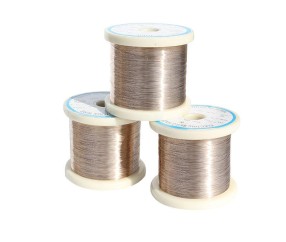Is Copper Nickel Alloy Magnetic
Release time:2025-12-29 Strike:717 Inquire Now
Copper-nickel alloys are generally non-magnetic in most practical applications. This is due to their specific composition and atomic structure, which lack the ferromagnetic properties typically seen in materials like iron, cobalt, or nickel in their pure forms.

Key Factors:
Nickel Content: Although pure nickel is ferromagnetic, when alloyed with copper, the magnetic properties are significantly diminished. This is because copper disrupts the magnetic domains that would normally align in nickel, neutralizing its magnetic behavior.
Common Copper-Nickel Alloys:
CuNi 90/10 (90% Copper, 10% Nickel): Non-magnetic.
CuNi70/30 (70% Copper, 30% Nickel): Non-magnetic.
Applications: The non-magnetic nature of copper-nickel alloys makes them ideal for applications requiring resistance to electromagnetic interference, such as in marine environments, electrical components, and coinage.
If higher nickel content is present (as in alloys leaning towards pure nickel), slight magnetic behavior might be observed but typically remains negligible in standard c
Copper-nickel alloys, also known as white copper, are a group of alloys containing varying amounts of copper and nickel as well as other elements. The most common alloy in this group is CuNi 90/10, which consists of 90% copper and 10% nickel. These alloys are known for their excellent corrosion resistance, high thermal conductivity and good mechanical properties. However, when it comes to the magnetic properties of copper-nickel alloys, it is important to understand that their behavior is influenced by a variety of factors.
In general, copper-nickel alloys are considered non-magnetic or weakly magnetic. The magnetic properties of an alloy are largely determined by its composition, crystal structure and heat treatment. Copper itself is non-magnetic, while nickel is ferromagnetic, which means it can be magnetic under certain conditions. When combined in a copper-nickel alloy, the overall magnetic behavior is usually dominated by the non-magnetic nature of the copper.
The crystal structure of the alloy plays a crucial role in determining its magnetic properties. Copper-nickel alloys typically have a face-centered cubic (FCC) crystal structure, which is not magnetic, and the FCC crystal structure determines the non-magnetic or weakly magnetic behavior exhibited by these alloys. Nickel is ferromagnetic and therefore may introduce some magnetic properties, but the overall effect is usually limited.
It is important to note that the magnetic properties of copper-nickel alloys are affected by the specific composition of the alloy. Alloys with higher nickel content may exhibit slightly stronger magnetic properties, but they are still usually considered non-magnetic compared to ferromagnetic materials.
Heat treatment can also affect the magnetic properties of copper-nickel alloys. Annealing or other heat treatments may alter the crystal structure and magnetic properties of the alloy. However, even after heat treatment, CuNi alloys tend to retain their non-magnetic or weak magnetic properties.
In practical applications, the non-magnetic properties of copper-nickel alloys are advantageous, especially in industries where magnetic interference is a concern. This property makes them suitable for use in electrical and electronic applications, marine environments and minting.
Copper-nickel alloys (e.g. CuNi 90/10) are generally not magnetic or weakly magnetic due to their face-centered cubic crystal structure and the non-magnetic nature of copper. Although variations in composition and heat treatment may affect their magnetic properties to some extent, these alloys are favored for their corrosion resistance and other desirable properties over non-magnetism.
-
How to Apply for BIS Certificate India
Here is a clear explanation in English on how to apply for a BIS...
-

Alloy28 Stainless steel with 28% Cr and 3% Mo
🔧 UNS N08028 Stainless Steel – Overview and ApplicationsUNS N080...
-

Exploring the Applications of Resistance Wire: From Industrial Heating to Electric Vehicles
Resistance wire is a specialized material widely used in various...
-

How to Caculate the Nichrome80 Temperature
We’re super stoked about our Nichrome 80 wire, a go-to for high-...



